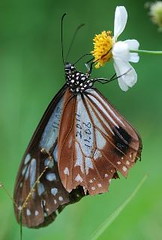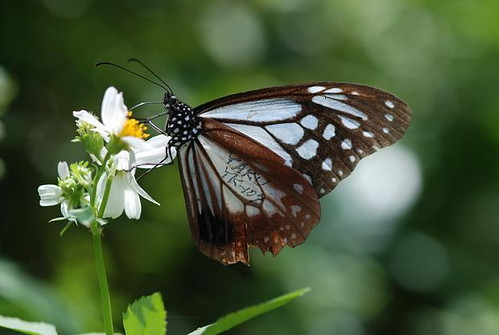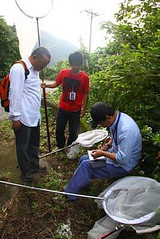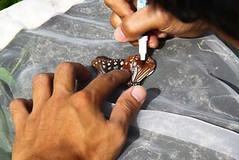New York Times By CARL ZIMMER
Published: January 25, 2011
 A male Acmon blue butterfly (Icaricia acmon). Vladimir Nabokov described the Icaricia genus in 1944. In a speculative moment in 1945, he came up with a sweeping hypothesis for the evolution the group of butterflies known as the Polyommatus blues, and 65 years later, DNA analysis has proved it correct.
A male Acmon blue butterfly (Icaricia acmon). Vladimir Nabokov described the Icaricia genus in 1944. In a speculative moment in 1945, he came up with a sweeping hypothesis for the evolution the group of butterflies known as the Polyommatus blues, and 65 years later, DNA analysis has proved it correct.
Vladimir Nabokov may be known to most people as the author of classic novels like “Lolita” and “Pale Fire.” But even as he was writing those books, Nabokov had a parallel existence as a self-taught expert on butterflies.
He was the curator of lepidoptera at the Museum of Comparative Zoology at Harvard University, and collected the insects across the United States. He published detailed descriptions of hundreds of species. And in a speculative moment in 1945, he came up with a sweeping hypothesis for the evolution of the butterflies he studied, a group known as the Polyommatus blues. He envisioned them coming to the New World from Asia over millions of years in a series of waves.
Few professional lepidopterists took these ideas seriously during Nabokov’s lifetime. But in the years since his death in 1977, his scientific reputation has grown. And over the past 10 years, a team of scientists has been applying gene-sequencing technology to his hypothesis about how Polyommatus blues evolved. On Tuesday in the Proceedings of the Royal Society of London, they reported that Nabokov was absolutely right.
“It’s really quite a marvel,” said Naomi Pierce of Harvard, a co-author of the paper.
 A male Andean blue butterfly (Madeleinea koa). A new study shows that the ancestors of this species colonized the New World from Asia via Beringia 11 million years ago.
A male Andean blue butterfly (Madeleinea koa). A new study shows that the ancestors of this species colonized the New World from Asia via Beringia 11 million years ago.Nabokov inherited his passion for butterflies from his parents. When his father was imprisoned by the Russian authorities for his political activities, the 8-year-old Vladimir brought a butterfly to his cell as a gift. As a teenager, Nabokov went on butterfly-hunting expeditions and carefully described the specimens he caught, imitating the scientific journals he read in his spare time. Had it not been for the Russian Revolution, which forced his family into exile in 1919, Nabokov said that he might have become a full-time lepidopterist.
In his European exile, Nabokov visited butterfly collections in museums. He used the proceeds of his second novel, “King, Queen, Knave,” to finance an expedition to the Pyrenees, where he and his wife, Vera, netted over a hundred species. The rise of the Nazis drove Nabokov into exile once more in 1940, this time to the United States. It was there that Nabokov found his greatest fame as a novelist. It was also there that he delved deepest into the science of butterflies.
Nabokov spent much of the 1940s dissecting a confusing group of species called Polyommatus blues. He developed forward-thinking ways to classify the butterflies based on differences in their genitalia. He argued that what were thought to be closely related species were actually only distantly related.
 A male blue butterfly of the genus Lycaeides. The study shows that the ancestors of this species colonized the New World from Asia through Beringia approximately 2.4 million years ago.
A male blue butterfly of the genus Lycaeides. The study shows that the ancestors of this species colonized the New World from Asia through Beringia approximately 2.4 million years ago.At the end of a 1945 paper on the group, he mused on how they had evolved. He speculated that they originated in Asia, moved over the Bering Strait, and moved south all the way to Chile.
Allowing himself a few literary flourishes, Nabokov invited his readers to imagine “a modern taxonomist straddling a Wellsian time machine.” Going back millions of years, he would end up at a time when only Asian forms of the butterflies existed. Then, moving forward again, the taxonomist would see five waves of butterflies arriving in the New World.
Nabokov conceded that the thought of butterflies making a trip from Siberia to Alaska and then all the way down into South America might sound far-fetched. But it made more sense to him than an unknown land bridge spanning the Pacific. “I find it easier to give a friendly little push to some of the forms and hang my distributional horseshoes on the nail of Nome rather than postulate transoceanic land-bridges in other parts of the world,” he wrote.
When “Lolita” made Nabokov a star in 1958, journalists were delighted to discover his hidden life as a butterfly expert. A famous photograph of Nabokov that appeared in The Saturday Evening Post when he was 66 is from a butterfly’s perspective. The looming Russian author swings a net with rapt concentration. But despite the fact that he was the best-known butterfly expert of his day and a Harvard museum curator, other lepidopterists considered Nabokov a dutiful but undistinguished researcher. He could describe details well, they granted, but did not produce scientifically important ideas.
Only in the 1990s did a team of scientists systematically review his work and recognize the strength of his classifications. Dr. Pierce, who became a Harvard biology professor and curator of lepidoptera in 1990, began looking closely at Nabokov’s work while preparing an exhibit to celebrate his 100th birthday in 1999. She was captivated by his idea of butterflies coming from Asia. “It was an amazing, bold hypothesis,” she said. “And I thought, ‘Oh, my God, we could test this.’ ”
 The study took eight years and involved collecting samples from Canada to Patagonia. Roger Vila, one of the authors of the study, is shown prospecting in the Cajamarca region of Peru.
The study took eight years and involved collecting samples from Canada to Patagonia. Roger Vila, one of the authors of the study, is shown prospecting in the Cajamarca region of Peru.To do so, she would need to reconstruct the evolutionary tree of blues, and estimate when the branches split. It would have been impossible for Nabokov to do such a study on the anatomy of butterflies alone. Dr. Pierce would need their DNA, which could provide more detail about their evolutionary history.
Working with American and European lepidopterists, Dr. Pierce organized four separate expeditions into the Andes in search of blues. Back at her lab at Harvard, she and her colleagues sequenced the genes of the butterflies and used a computer to calculate the most likely relationships between them. They also compared the number of mutations each species had acquired to determine how long ago they had diverged from one another.
 A greenish blue Icaricia saepiolus waiting for the sun on a dandelion. Its ancestors crossed from Asia to the Americas through Beringia nine million years ago.
A greenish blue Icaricia saepiolus waiting for the sun on a dandelion. Its ancestors crossed from Asia to the Americas through Beringia nine million years ago.There were several plausible hypotheses for how the butterflies might have evolved. They might have evolved in the Amazon, with the rising Andes fragmenting their populations. If that were true, the species would be closely related to one another.
 The study confirms Vladimir Nabokov's biogeographic hypothesis for the colonization of the New World by Polyommatus butterflies. They crossed from Asia to the Americas through Beringia at least five times in the last 11 million years.
The study confirms Vladimir Nabokov's biogeographic hypothesis for the colonization of the New World by Polyommatus butterflies. They crossed from Asia to the Americas through Beringia at least five times in the last 11 million years.But that is not what Dr. Pierce found. Instead, she and her colleagues found that the New World species shared a common ancestor that lived about 10 million years ago. But many New World species were more closely related to Old World butterflies than to their neighbors. Dr. Pierce and her colleagues concluded that five waves of butterflies came from Asia to the New World — just as Nabokov had speculated.
“By God, he got every one right,” Dr. Pierce said. “I couldn’t get over it — I was blown away.”
Dr. Pierce and her colleagues also investigated Nabokov’s idea that the butterflies had come over the Bering Strait. The land surrounding the strait was relatively warm 10 million years ago, and has been chilling steadily ever since. Dr. Pierce and her colleagues found that the first lineage of Polyommatus blues that made the journey could survive a temperature range that matched the Bering climate of 10 million years ago. The lineages that came later are more cold-hardy, each with a temperature range matching the falling temperatures.
Nabokov’s taxonomic horseshoes turn out to belong in Nome after all.
"What a great paper," said James Mallet, an expert on butterfly evolution at University College London. "It's a fitting tribute to the great man to see that the most modern methods that technology can deliver now largely support his systematic arrangement."
 A group of Polyommatus blue butterflies gathering in humid soil. The study shows that Beringia has served as a biological corridor for their dispersal from Asia into the New World, as is the case with other animals, including humans.
A group of Polyommatus blue butterflies gathering in humid soil. The study shows that Beringia has served as a biological corridor for their dispersal from Asia into the New World, as is the case with other animals, including humans.Dr. Pierce says she believes Nabokov would have been greatly pleased to be so vindicated, and points to one of his most famous poems, “On Discovering a Butterfly.” The 1943 poem begins:
I found it and I named it, being versed
in taxonomic Latin; thus became
godfather to an insect and its first
describer — and I want no other fame.
“He felt that his scientific work was standing for all time, and that he was just a player in a much bigger enterprise,” said Dr. Pierce. “He was not known as a scientist, but this certainly indicates to me that he knew what it’s all about.”











 Vladimir Nabokov may be known to most people as the author of classic novels like “Lolita” and “Pale Fire.” But even as he was writing those books, Nabokov had a parallel existence as a self-taught expert on butterflies.
Vladimir Nabokov may be known to most people as the author of classic novels like “Lolita” and “Pale Fire.” But even as he was writing those books, Nabokov had a parallel existence as a self-taught expert on butterflies.




